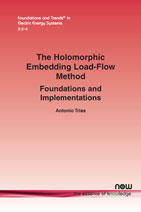HELM: The Holomorphic Embedding Load-Flow Method. Foundations and Implementations
By Antonio Trias, Aplicaciones en Informática Avanzada, Spain, triast@aia.es
Abstract
The Holomorphic Embedding Load-Flow Method (HELM) was recently introduced as a novel technique to constructively solve the power flow equations in power networks, based on advanced concepts from complex analysis, algebraic curves, and modern techniques in approximation theory. In contrast to traditional methods, which rely on numerical iterative schemes whose convergence is often subject to varying degrees of uncertainty, HELM’s results are always guaranteed and unequivocal: if the power flow problem is feasible, it constructs the most desirable solution; and conversely, if the power flow problem is infeasible, it signals such condition reliably. Additionally, the significance of HELM extends beyond its utilitarian role as a reliable power flow solver, since the theory backing this method is proving to be a fertile ground for the development of new analysis tools for power systems. This work covers the HELM method from the ground up. It revisits its theoretical foundations in detail, stressing the importance of some key ideas grounded in the physics of the problem. These provide the necessary intuition for the mathematical developments to follow; in particular, for the introduction of the holomorphic embedding as a way to turn the original problem into the study of a plane algebraic curve, where the branches represent the power flow solutions. This is shown to be a natural way to characterize the multiple solutions to the problem, answering some deep practical questions such as: in the absence of information about dynamic stability, which of the power flow solutions is the most desirable one for the operation of a power system? The formulations cover both traditional ac networks and dc networks (which are gaining importance in microgrids, spacecraft, and electric aircraft). Special attention is paid to the analytic continuation of power series, in particular to the calculation of Padé approximants. It also serves to introduce the topic of higher order rational approximants, which allow reproducing the nose points around voltage collapse with better numerical stability than their Padé counterparts. An interesting by-product of this theory, Sigma plots, is shown to be a useful graphical tool for the quick visual assessment and diagnosis of both feasible and unfeasible cases. Controls, such as voltage regulation by generators, are first incorporated into the method as algebraic equality constraints, with no limits in the controlling variables. The method also covers a formulation that allows for possible conflicts between the specified controls, solving them optimally. Also cover how to deal with control limits, without resorting to control type-switching approaches, presenting a novel Lagrangian formulation and using the Padé-Weierstrass (P-W) HELM method, a special analytic continuation technique that greatly increases the precision achievable with HELM.
HELM: The Holomorphic Embedding Load-Flow Method. Foundations and Implementations
The Holomorphic Embedding Load-Flow Method (HELM) was recently introduced as a novel technique to constructively solve the power flow equations in power networks, based on advanced concepts from complex analysis, algebraic curves, and modern techniques in approximation theory. HELM’s results are always guaranteed and unequivocal: if the power flow problem is feasible, it constructs the most desirable solution; and conversely, if the power flow problem is infeasible, it signals such condition reliably.
This monograph provides the first in-depth and comprehensive overview of HELM. Starting by revisiting the theoretical foundations, it proceeds to develop the complete mathematical basis required to develop practical solutions to the problem. These formulations cover both ac and dc networks.The significance of HELM extends beyond its utilitarian role as a reliable power flow solver, since the theory backing this method is proving to be a fertile ground for the development of new analysis tools for power systems.
This monograph is a must-read for all students and researchers working on the cutting edge of electric power systems.
